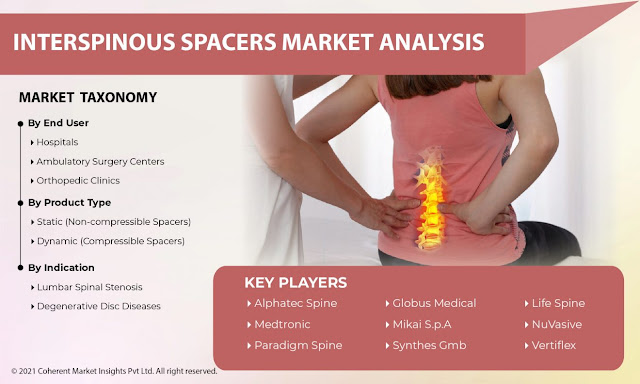"Interspinous Process Decompression Devices Market: A Comprehensive Analysis"
The Interspinous
Process Decompression (IPD) Devices Market has witnessed significant growth and
innovation in recent years. These devices play a crucial role in the treatment
of various spine-related conditions, offering patients a minimally invasive alternative
to traditional surgical procedures. In this blog, we will explore the key
developments and trends in the IPD devices market, highlighting the factors
contributing to its expansion.
Understanding
Interspinous Process Decompression Devices
Interspinous
Process Decompression (IPD) devices are implantable medical devices designed to
alleviate symptoms associated with spinal stenosis, a common condition
characterized by the narrowing of the spinal canal. This narrowing often
results in compression of spinal nerves, leading to pain, numbness, and limited
mobility. IPD devices are intended to address these issues by providing
stability to the spine and restoring proper spacing between vertebrae.
Key Market Drivers
1. Aging
Population: The aging population is a significant driver of the IPD devices
market. As people age, they become more susceptible to degenerative spine
conditions such as spinal stenosis. IPD devices offer a less invasive treatment
option for older patients who may not be ideal candidates for traditional open
surgeries.
2. Minimally
Invasive Procedures: Patients are increasingly seeking minimally invasive
treatment options, and IPD devices fit the bill perfectly. These devices can be
implanted through small incisions, reducing surgical trauma, postoperative
pain, and recovery time.
3. Technological
Advancements: The IPD devices market has benefited from continuous
technological advancements. Improved materials, innovative designs, and
enhanced surgical techniques have contributed to the effectiveness and safety
of these devices.
4. Growing
Awareness: Both patients and healthcare professionals are becoming more aware
of the benefits of IPD devices. This increased awareness is driving demand for
these devices as patients seek alternatives to traditional surgery.
Key Players in the
Market
Several companies
are leading the charge in the
IPD devices market, with a focus on research, development, and product
innovation. Some of the prominent players include:
1. Medtronic
2. Vertiflex
(Acquired by Boston Scientific)
3. Paradigm
Spine (Acquired by RTI Surgical)
4. SI-BONE
5. Globus
Medical
Market Challenges
While the IPD
devices market is expanding, it also faces some challenges:
1. Regulatory
Hurdles: The regulatory approval process for medical devices can be lengthy and
complex. Manufacturers must navigate regulatory requirements in different
countries, which can impact the availability of IPD devices in certain markets.
2. Reimbursement
Issues: Reimbursement policies for IPD procedures vary by region and can affect
patient access to these treatments. Manufacturers and healthcare providers need
to work together to address reimbursement challenges.
Conclusion
The
Interspinous Process Decompression (IPD) Devices Market Size is poised for
continued growth as it addresses the needs of an aging population seeking less
invasive treatment options for spinal conditions. With ongoing technological
advancements and increasing awareness among patients and healthcare
professionals, the future of IPD devices looks promising. However, overcoming
regulatory and reimbursement challenges will be crucial in ensuring that
patients can access these innovative treatments when needed.
Read More….
Pharma
Grade Magnesium Trisilicate Market
Non-alcoholic
Steatohepatitis (NASH) Therapeutics and Diagnostics Market
Indefinite
Volume Pipette Market
Postpartum
Depression Drug Market




Comments
Post a Comment